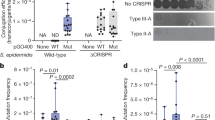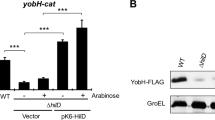Abstract
Staphylococcal pathogenicity islands (SaPIs) are a family of closely related mobile chromosomal islands that encode and disseminate the superantigen toxins, toxic shock syndrome toxin 1 and superantigen enterotoxin B (SEB). They are regulated by master repressors, which are counteracted by helper phage–encoded proteins, thereby inducing their excision, replication, packaging and intercell transfer. SaPIs are major components of the staphylococcal mobilome, occupying five chromosomal att sites, with many strains harbouring two or more. As regulatory interactions between co-resident SaPIs could have profound effects on the spread of superantigen pathobiology, we initiated the current study to search for such interactions. Using classical genetics, we found that, with one exception, their regulatory systems do not cross-react. The exception was SaPI3, which was originally considered defective because it could not be mobilized by any known helper phage. We show here that SaPI3 has an atypical regulatory module and is induced not by a phage but by many other SaPIs, including SaPI2, SaPIbov1 and SaPIn1, each encoding a conserved protein, Sis, which counteracts the SaPI3 repressor, generating an intracellular regulatory cascade: the co-resident SaPI, when conventionally induced by a helper phage, expresses its sis gene which, in turn, induces SaPI3, enabling it to spread. Using bioinformatics analysis, we have identified more than 30 closely related coancestral SEB-encoding SaPI3 relatives occupying the same att site and controlled by a conserved regulatory module, immA–immR–str′. This module is functionally analogous but unrelated to the typical SaPI regulatory module, stl–str. As SaPIs are phage satellites, SaPI3 and its relatives are SaPI satellites.
This is a preview of subscription content, access via your institution
Access options
Access Nature and 54 other Nature Portfolio journals
Get Nature+, our best-value online-access subscription
$29.99 / 30 days
cancel any time
Subscribe to this journal
Receive 12 digital issues and online access to articles
$119.00 per year
only $9.92 per issue
Buy this article
- Purchase on Springer Link
- Instant access to full article PDF
Prices may be subject to local taxes which are calculated during checkout






Similar content being viewed by others
Data availability
No original sequence data were generated in this study. Accession codes for nucleotide sequences harbouring the studied sis homologues are as follows: SaPI1 (U93688), SaPI2 (EF010993), SaPI3 (NC_002951), SaPI4 (NC_002951), SaPI5 (NC_007793), SaPIn1 (NC_002745), SaPIbov1 (NC_007622), SaPIbov2 (AY220730), SaPIbov4 (HM211303) and SaPIbov5 (HM228919). Source data are provided with this paper.
References
Lindsay, J. A., Ruzin, A., Ross, H. F., Kurepina, N. & Novick, R. P. The gene for toxic shock toxin is carried by a family of mobile pathogenicity islands in Staphylococcus aureus. Mol. Microbiol. 29, 527–543 (1998).
Gillet, Y. et al. Association between Staphylococcus aureus strains carrying gene for Panton–Valentine leukocidin and highly lethal necrotising pneumonia in young immunocompetent patients. Lancet 359, 753–759 (2002).
Penadés, J. R. & Christie, G. E. The phage-inducible chromosomal islands: a family of highly evolved molecular parasites. Annu. Rev. Virol. 2, 181–201 (2015).
Novick, R. P. Pathogenicity islands and their role in staphylococcal biology. Microbiol. Spectr. https://doi.org/10.1128/microbiolspec.GPP3-0062-2019 (2019).
Tormo, M. A. et al. Staphylococcus aureus pathogenicity island DNA is packaged in particles composed of phage proteins. J. Bacteriol. 190, 2434–2440 (2008).
Tormo-Más, M. Á. et al. Moonlighting bacteriophage proteins derepress staphylococcal pathogenicity islands. Nature 465, 779–782 (2010).
Tormo-Más, M. Á. et al. Phage dUTPases control transfer of virulence genes by a proto-oncogenic G protein-like mechanism. Mol. Cell 49, 947–958 (2013).
Bowring, J. et al. Pirating conserved phage mechanisms promotes promiscuous staphylococcal pathogenicity island transfer. Elife 6, e26487 (2017).
Ciges-Tomas, J. R. et al. The structure of a polygamous repressor reveals how phage-inducible chromosomal islands spread in nature. Nat. Commun. 10, 3676 (2019).
Novick, R. P., Christie, G. E. & Penadés, J. R. The phage-related chromosomal islands of Gram-positive bacteria. Nat. Rev. Microbiol. 8, 541–551 (2010).
Ubeda, C. et al. SaPI mutations affecting replication and transfer and enabling autonomous replication in the absence of helper phage. Mol. Microbiol. 67, 493–503 (2008).
Bose, B., Auchtung, J. M., Lee, C. A. & Grossman, A. D. A conserved anti-repressor controls horizontal gene transfer by proteolysis. Mol. Microbiol. 70, 570–582 (2008).
Ram, G. et al. Staphylococcal pathogenicity island interference with helper phage reproduction is a paradigm of molecular parasitism. Proc. Natl Acad. Sci. USA 109, 16300–16305 (2012).
Ram, G., Chen, J., Ross, H. F. & Novick, R. P. Precisely modulated pathogenicity island interference with late phage gene transcription. Proc. Natl Acad. Sci. USA 111, 14536–14541 (2014).
Fillol-Salom, A. et al. Phage-inducible chromosomal islands are ubiquitous within the bacterial universe. ISME J. 12, 2114–2128 (2018).
Fillol-Salom, A. et al. Hijacking the hijackers: Escherichia coli pathogenicity islands redirect helper phage packaging for their own benefit. Mol. Cell 75, 1020–1030.e4 (2019).
Ubeda, C. et al. Antibiotic-induced SOS response promotes horizontal dissemination of pathogenicity island-encoded virulence factors in staphylococci. Mol. Microbiol. 56, 836–844 (2005).
Ubeda, C. et al. SaPI operon I is required for SaPI packaging and is controlled by LexA. Mol. Microbiol. 65, 41–50 (2007).
Quiles-Puchalt, N. et al. Staphylococcal pathogenicity island DNA packaging system involving cos-site packaging and phage-encoded HNH endonucleases. Proc. Natl Acad. Sci. USA 111, 6016–6021 (2014).
Schindelin, J. et al. Fiji: an open-source platform for biological-image analysis. Nat. Methods 9, 676–682 (2012).
Sullivan, M. J., Petty, N. K. & Beatson, S. A. Easyfig: a genome comparison visualizer. Bioinformatics 27, 1009–1010 (2011).
Bawono, P. & Heringa, J. PRALINE: a versatile multiple sequence alignment toolkit. Methods Mol. Biol. 1079, 245–262 (2014).
Acknowledgements
This work was supported by grants MR/V000772/1, MR/M003876/1 and MR/S00940X/1 from the Medical Research Council (UK); BB/N002873/1, BB/S003835/1 and BB/V002376/1 from the Biotechnology and Biological Sciences Research Council (BBSRC, UK); Wellcome Trust 201531/Z/16/Z; ERC-ADG-2014 Proposal no. 670932 Dut-signal from EU to J.R.P; and grants from the Ministry of Education (MOE), MOE2017-T2-2-163 and MOE2019-T2-2-162, to J.C. J.R.P. thanks the Royal Society and the Wolfson Foundation for providing him support through a Royal Society Wolfson Fellowship. We thank L. Lemgruber Soares of the Glasgow Imaging Facility for their support and assistance in this work.
Author information
Authors and Affiliations
Contributions
R.P.N. and J.R.P. conceived the study. A.F.H., M.P., R.I-C., F.G.d.S. and G.R. conducted the experiments. A.F.H., M.P., J.C., A.M., R.P.N. and J.R.P analysed the data. R.P.N. and J.R.P wrote the manuscript.
Corresponding authors
Ethics declarations
Competing interests
The authors declare no competing interests.
Additional information
Peer review information Nature Microbiology thanks the anonymous reviewers for their contribution to the peer review of this work. Peer reviewer reports are available.
Publisher’s note Springer Nature remains neutral with regard to jurisdictional claims in published maps and institutional affiliations.
Supplementary information
Supplementary Information
Supplementary Figs. 1–13, Tables 1–9 and References.
Supplementary Data 1
Supplementary Excel workbook containing source data and statistical analyses for Fig. 1.
Supplementary Data 2
Supplementary Excel workbook containing source data and statistical analyses for Fig. 2.
Supplementary Data 3
Supplementary Excel workbook containing source data and statistical analyses for Fig. 4.
Supplementary Data 4
Supplementary Excel workbook containing source data and statistical analyses for Fig. 5.
Supplementary Data 5
Supplementary Excel workbook containing source data and statistical analyses for Fig. S2.
Supplementary Data 6
Supplementary Excel workbook containing source data and statistical analyses for Fig. S6.
Supplementary Data 7
Supplementary Excel workbook containing source data and statistical analyses for Fig. S7.
Supplementary Data 8
Supplementary Excel workbook containing source data and statistical analyses for Fig. S8.
Supplementary Data 9
Supplementary Excel workbook containing source data and statistical analyses for Fig. S9.
Supplementary Data 10
Supplementary Excel workbook containing source data and statistical analyses for Fig. S10.
Supplementary Data 11
Supplementary Excel workbook containing source data and statistical analyses for Fig. S11.
Source data
Source Data Fig. 1
Uncropped Southern blots.
Source Data Fig. 2
Uncropped Southern blots.
Rights and permissions
About this article
Cite this article
Haag, A.F., Podkowik, M., Ibarra-Chávez, R. et al. A regulatory cascade controls Staphylococcus aureus pathogenicity island activation. Nat Microbiol 6, 1300–1308 (2021). https://doi.org/10.1038/s41564-021-00956-2
Received:
Accepted:
Published:
Issue Date:
DOI: https://doi.org/10.1038/s41564-021-00956-2
This article is cited by
-
The ClpX protease is essential for inactivating the CI master repressor and completing prophage induction in Staphylococcus aureus
Nature Communications (2023)
-
Bacterial chromosomal mobility via lateral transduction exceeds that of classical mobile genetic elements
Nature Communications (2021)



